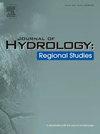金沙江流域大库群径流对气候变化响应的累积与抵消效应
IF 5
2区 地球科学
Q1 WATER RESOURCES
引用次数: 0
摘要
研究区域金沙江流域,位于中国长江流域上游,金沙江流域是世界上最大的水电基地。在这项研究中,我们提出了一种新的方法来分离水库对不同流域的流量影响和响应机制。我们将XGBoost (eXtreme Gradient Boosting)、CNN-LSTM(卷积神经网络,长短期记忆)和Informer与6个水文站的数据相结合,进行了流量重建。以传统水文模型SWAT (Soil and Water Assessment Tool)为基准。2010年以后,水库群对河流流量的平均影响为40.7 %,8月份对河流流量的影响最大,上游为20 %,中游为42 %,下游为60 %。水库调节显著改变了JRB的季节性流型(尤其是枯水期)。汛期(6 ~ 11月)极端湿(SDI≥2)条件下,水库最大调节流量抵消量在14.3 % ~ 28.6 %之间变化(2000 ~ 4000 m3/s,其中Qmax=14000 m3/s)。反之,在枯水期极端干旱(SDI≤-2)条件下,水库调节的流量累积占25 - 44.4% % (Qmax=1800 m3/s中的100-800 m3/s)。此外,XGBoost模型可为气候变化条件下的河流流量重建和预报提供一种新的方法,特别是对水库群的量化。水库蓄水效率在中游较为明显,尤其是在2015年以后(以归一化差(sre -观测)>; 0更频繁),而下游在2010年以后释放较多(以归一化差<;0更频繁)。与大尺度大气环流指数相比,径流重建模拟与流域径流的相关性更强。研究结果表明,该模型在气候变化和水库条件下对河流重建的预测是可靠的,为大型水库运行引起的极端河流事件预警提供了一种新的推理方法。本文章由计算机程序翻译,如有差异,请以英文原文为准。
Cumulative and offsetting effects of Streamflow Response to Climate change and Large Reservoir Group in the Jinsha River Basin, China
Study Region
Jinsha River Basin (JRB), situated in the upper sections of the Yangtze River basin, China
Study Focus
The Jinsha River Basin (JRB), renowned as the world's largest hydropower base. In this study, we proposed a novel approach for separating the reservoir's influence on streamflow and the response mechanisms in diverse watersheds. We integrated XGBoost (the eXtreme Gradient Boosting), CNN-LSTM (Convolutional Neural Networks, Long Short-Term Memory) and Informer with 6 hydrological stations data for streamflow reconstruction. Traditional hydrological model SWAT (Soil and Water Assessment Tool) served as a benchmark.
New Hydrological Insights for the Region
Reservoir groups were exerting average 40.7 % influence on streamflow after 2010, altering the streamflow with maximum 20 % in the upstream, 42 % midstream and 60 % downstream in August in JRB. Also, reservoir regulation significantly shifted the seasonal streamflow pattern (especially low water season) in the JRB. Under extreme wet (SDI≥2) in flood season (June-November), the maximum reservoir regulated streamflow offsetting varied between 14.3 % and 28.6 % (2000–4000 m3/s out of Qmax=14000 m3/s). Conversely, under extreme drought (SDI≤-2) in the low water season, reservoir regulated streamflow accumulation accounted for 25–44.4 % (100–800 m3/s out of Qmax=1800 m3/s). Moreover, the XGBoost model can provide a new way for streamflow reconstruction and forecast, particularly in the quantification of the reservoir groups under climate change. Reservoir storage efficiency was more obvious in the midstream, especially after 2015 (with normalized difference (Sreconstruction – Sobservation)> 0 more frequent), while released more in the downstream after 2010 (with normalized difference<0 more frequent). The streamflow reconstruction simulation had a stronger correlation with the catchment streamflow than large-scale atmospheric circulation indices. In summary, our study demonstrates models forecast reliability in streamflow reconstruction under climate change and reservoirs, providing a new reasoning approach for extreme streamflow event early warning resulting from large reservoir operations.
求助全文
通过发布文献求助,成功后即可免费获取论文全文。
去求助
来源期刊

Journal of Hydrology-Regional Studies
Earth and Planetary Sciences-Earth and Planetary Sciences (miscellaneous)
CiteScore
6.70
自引率
8.50%
发文量
284
审稿时长
60 days
期刊介绍:
Journal of Hydrology: Regional Studies publishes original research papers enhancing the science of hydrology and aiming at region-specific problems, past and future conditions, analysis, review and solutions. The journal particularly welcomes research papers that deliver new insights into region-specific hydrological processes and responses to changing conditions, as well as contributions that incorporate interdisciplinarity and translational science.
 求助内容:
求助内容: 应助结果提醒方式:
应助结果提醒方式:


